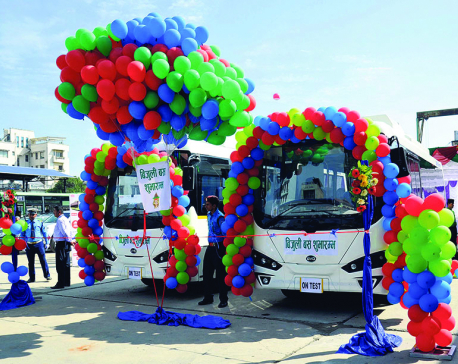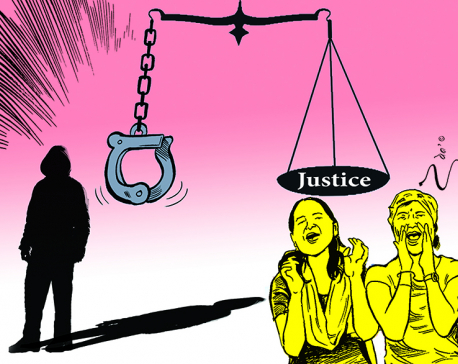
OR


Jaganath Karki
The author is pursuing doctorate study at University of West Scotland, UK on Financial Inclusion in Nepalnews@myrepublica.com
More from Author
Poverty, illiteracy and lack of access to financial services are key barriers to promoting entrepreneurship in Nepal
Kenya has emerged as a leader in financial inclusion in Sub-Saharan Africa. In 2006, just before M-Pesa—the country’s mobile money transfer service—was launched, only 26.7 percent Kenyans had access to formal financial services (such as bank accounts and money transfers). By 2016, it rose to over 75 percent.
M-Pesa was started in 2007 as an electronic money transfer product that enables users to store value on their mobile phones. It is based on a platform of electronic units of money that can be used for multiple purposes including transfers to other users, payments for goods and services, and conversion to and from cash. Financial institutions have embraced M-Pesa as a platform to manage micro accounts, build customer deposits and broaden their customer network.
Almost 100 percent Swedish have a bank account due to which the use of the cash is falling, which means that many shops no longer accept it. It costs a lot of money to take cash, and it’s simply not viable for them. Financial inclusion was fostered by both government and the private sector.
Generally, financial exclusion is regarded as a lack of access to financial products and services. However, the World Bank has defined financial exclusion as a lack of banking access, access to credit facilities and access to insurance.
Case of Nepal
The World Economic Forum ranks Nepal in 65th position in terms of ease of access to the loan out of 137 countries studied. Similarly, Nepal is ranked 110 among 190 economies in the Ease of Doing Business, according to the latest World Bank annual ratings. The rank of Nepal deteriorated to 110 in 2018 from 105 in 2017. This indicates that Nepal is not ready for promoting entrepreneurship although the government’s stated vision is to achieve the goal of “Prosperous Nepal and Happy Nepali.”
According to the central bank of Nepal, there are 28 commercial banks (A class), 57 development banks (class B), 36 finance companies (class C), 48 microfinance institutes (class D) and 15 credit cooperatives. This shows that financial institutions are yet to reach out to a huge number of financially excluded Nepalis. E-payment and card payment service are mostly limited in Kathmandu, Biratnagar and Pokhara.
The United Nations estimates that that 31 percent of world’s adults are financially excluded. According to its report a total of 17 percent population are financially excluded in Africa while 38 percent of the financially excluded population live in the Asia Pacific region. The World Bank Rural Financial Inclusion and Poverty eradication report highlights that about half of the unbanked people include women and poor households in rural areas or those out of the workforce. This clearly shows that access to financial service is not available to the poor and disadvantageous in most part of the world.
In Nepal, the situation of financial exclusion is alarming. Nearly 60 percent of total population are still unbanked and financially excluded. According to a survey conducted by Finscope in 2014, 61 percent of the adults in the city area were using formal financial channel whereas 39 percent still remained unbanked. Among 61 percent who were using financial services only 40 percent were formally banked. Rest were using informal financial channels. This is a clear case of financial exclusion in Nepal.
Causes of exclusion
Many studies have found that illiteracy, poverty and lack of banking access are the main causes of financial exclusion. However, some studies point to government policies too. Interestingly, though Nepal is the fifth-highest remittance dependent country in terms of national GDP it lags far behind many African countries in terms of financial exclusion.
A study of UNDP based on a survey of 4,000 respondents gives an idea of expenditure and effects of remittances. The study conducted in 2015 suggested that remittance does not only have a positive impact on the level of income but also enables access to health care and education. Most remittances received are used for consumption (45 percent) whereas 11 percent is used for business investment and 12 percent for housing investment.
Size of informal economy is quite big in Nepal. According to a 2010 survey conducted by ILO, the size of the informal economy that runs without any formal financial banking channel and without any formal record of the government, was 50 percent of total GDP. Agriculture, the main source of economy which covers 33 percent of total economy, is itself considered under informal economy due to off-the record transaction and production.
According to ILO’s recent report, Nepal has one of the highest proportions of informal employment in the world (the highest in the Asia-Pacific region) with over 94 percent of the country’s workforce engaged in informal jobs. In Nepal, 90.7 percent of such jobs are in the informal sector followed by 3.4 percent and 0.2 percent in the formal sector and households respectively. In terms of gender distribution of informal jobs, Nepal’s 90.7 percent of men are in informal employment compared to 97.5 percent of Nepali women in similar works.
The government of Nepal, as well as the private sector financial organisations, seem to have overlooked the need to promote financial inclusion which could be the vital tool for transforming informal economy. This could also support government’s plan to promote entrepreneurship.
A study conducted in China has found that improving financial inclusion can promote farmers’ entrepreneurship. The urbanization level, economic openness and level of regional economic development have a significant positive effect on farmers’ entrepreneurship, according to the study.
Building entrepreneurship
Financial companies are seen to be focusing only on saving and handling remittances instead of promoting trade, investment and entrepreneurship. People in Nepal need to learn how to fish as well as making use of fishing equipment for prosperity instead of being satisfied with fish handed to them by some NGOs and INGOs. The banks should not just provide them credit but also take measures to support them to generate income through secure and efficient investment.
The government of Nepal has aimed to expand branches of banks to local level so as to provide accessibility of financial service to all. However, providing banking access and opening accounts are not adequate for the developing countries. Financial awareness and literacy are the keys.
My research has identified three key areas of reforms for financial inclusion. They include policy level reform, banks expanding financial market needs to raise people’s financial access and raising awareness among general public about modern financial products and services. In Nepal, the government has introduced agro-based entrepreneurship schemes and other microfinance organizations are also working to expand financial access to the disadvantaged population. Yet, a big number of educated youth see migration as a better option instead of taking up domestic entrepreneurial activities. The local microfinance companies are providing loans to local communities. But people in rural areas have not been able to capitalize on such loans to build entrepreneurship. Some farmers are already reeling under debt burden. Take India’s case. Farmers in India were provided the access credit yet many farmers committed suicide due to the inability to pay off the debt. Thus providing financial access alone won’t help unless financially illiterate people are made aware about debt, and appropriate policies are taken to address their needs.
Three key elements need to be considered: Enabling financial accessibility, raising entrepreneurial awareness and providing assistance to financially excluded people. Private and public financial institution and stakeholders should work together to promote financial inclusion through modern financial technologies such as branchless banking, mobile banking, post office banking among others.
The author is pursuing doctorate study at the University of West Scotland, UK on Financial Inclusion in Nepal
jnkarki@gmail.com
You May Like This

Reviving home remedies
Garlic has antibacterial, antivirus, antifungal, and antioxidant properties and nutrients. For this reason, garlic soup is used by many people... Read More...

Going electric
Nepal should aim for promoting electric vehicle technology. Strategic approach should be adopted to formulate policies to encourage people to... Read More...

Reimagining leadership
Transitional justice process has not come to a meaningful end because conflict victims were not placed at the center ... Read More...




Just In
- Rainbow tourism int'l conference kicks off
- Over 200,000 devotees throng Maha Kumbha Mela at Barahakshetra
- Indians vote in the first phase of the world’s largest election as Modi seeks a third term
- Kushal Dixit selected for London Marathon
- Nepal faces Hong Kong today for ACC Emerging Teams Asia Cup
- 286 new industries registered in Nepal in first nine months of current FY, attracting Rs 165 billion investment
- UML's National Convention Representatives Council meeting today
- Gandaki Province CM assigns ministerial portfolios to Hari Bahadur Chuman and Deepak Manange






_20220508065243.jpg)








Leave A Comment